Christopher P. Burgess
Linking vision and motion for self-supervised object-centric perception
Jul 14, 2023Abstract:Object-centric representations enable autonomous driving algorithms to reason about interactions between many independent agents and scene features. Traditionally these representations have been obtained via supervised learning, but this decouples perception from the downstream driving task and could harm generalization. In this work we adapt a self-supervised object-centric vision model to perform object decomposition using only RGB video and the pose of the vehicle as inputs. We demonstrate that our method obtains promising results on the Waymo Open perception dataset. While object mask quality lags behind supervised methods or alternatives that use more privileged information, we find that our model is capable of learning a representation that fuses multiple camera viewpoints over time and successfully tracks many vehicles and pedestrians in the dataset. Code for our model is available at https://github.com/wayveai/SOCS.
Constellation: Learning relational abstractions over objects for compositional imagination
Jul 23, 2021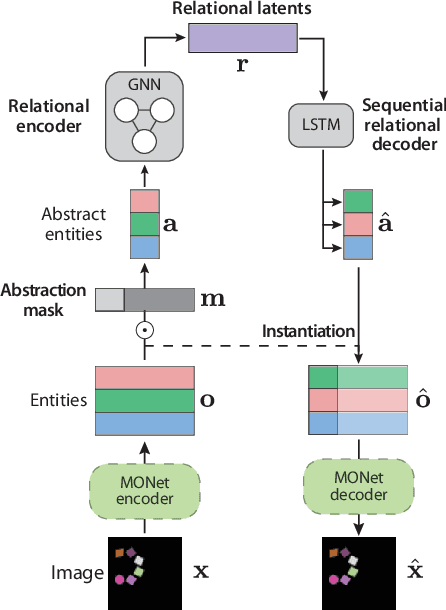
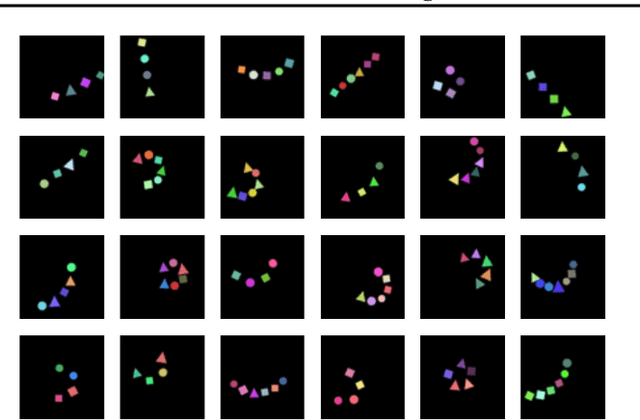
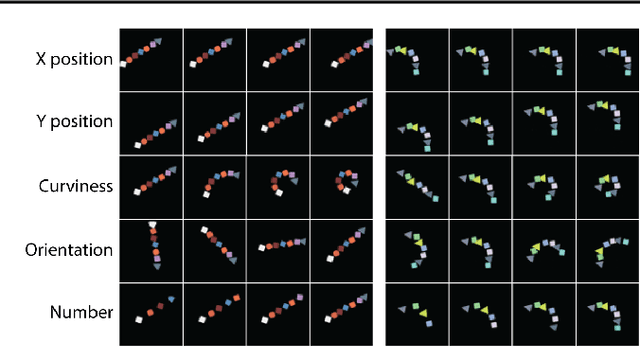
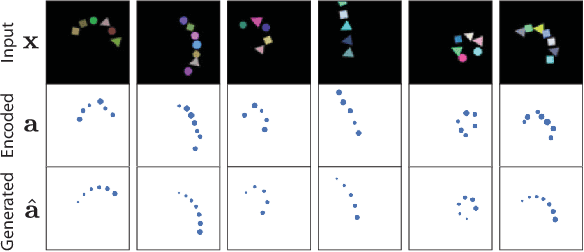
Abstract:Learning structured representations of visual scenes is currently a major bottleneck to bridging perception with reasoning. While there has been exciting progress with slot-based models, which learn to segment scenes into sets of objects, learning configurational properties of entire groups of objects is still under-explored. To address this problem, we introduce Constellation, a network that learns relational abstractions of static visual scenes, and generalises these abstractions over sensory particularities, thus offering a potential basis for abstract relational reasoning. We further show that this basis, along with language association, provides a means to imagine sensory content in new ways. This work is a first step in the explicit representation of visual relationships and using them for complex cognitive procedures.
SIMONe: View-Invariant, Temporally-Abstracted Object Representations via Unsupervised Video Decomposition
Jun 07, 2021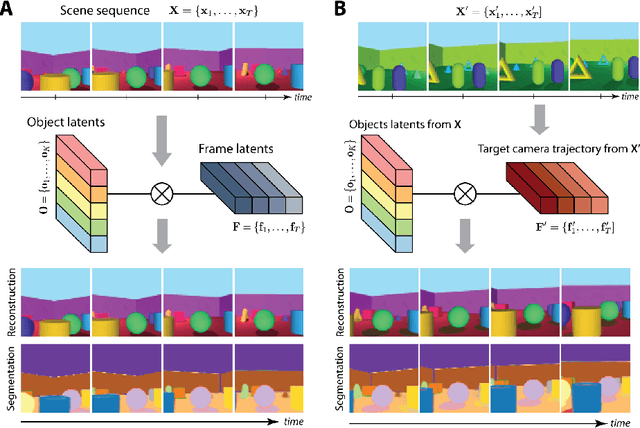

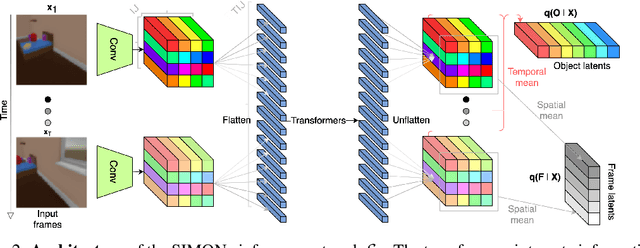

Abstract:To help agents reason about scenes in terms of their building blocks, we wish to extract the compositional structure of any given scene (in particular, the configuration and characteristics of objects comprising the scene). This problem is especially difficult when scene structure needs to be inferred while also estimating the agent's location/viewpoint, as the two variables jointly give rise to the agent's observations. We present an unsupervised variational approach to this problem. Leveraging the shared structure that exists across different scenes, our model learns to infer two sets of latent representations from RGB video input alone: a set of "object" latents, corresponding to the time-invariant, object-level contents of the scene, as well as a set of "frame" latents, corresponding to global time-varying elements such as viewpoint. This factorization of latents allows our model, SIMONe, to represent object attributes in an allocentric manner which does not depend on viewpoint. Moreover, it allows us to disentangle object dynamics and summarize their trajectories as time-abstracted, view-invariant, per-object properties. We demonstrate these capabilities, as well as the model's performance in terms of view synthesis and instance segmentation, across three procedurally generated video datasets.
A Heuristic for Unsupervised Model Selection for Variational Disentangled Representation Learning
May 29, 2019

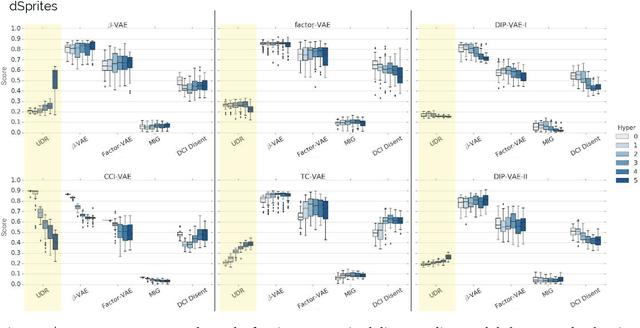

Abstract:Disentangled representations have recently been shown to improve data efficiency, generalisation, robustness and interpretability in simple supervised and reinforcement learning tasks. To extend such results to more complex domains, it is important to address a major shortcoming of the current state of the art unsupervised disentangling approaches -- high convergence variance, whereby different disentanglement quality may be achieved by the same model depending on its initial state. The existing model selection methods require access to the ground truth attribute labels, which are not available for most datasets. Hence, the benefits of disentangled representations have not yet been fully explored in practical applications. This paper addresses this problem by introducing a simple yet robust and reliable method for unsupervised disentangled model selection. We show that our approach performs comparably to the existing supervised alternatives across 5400 models from six state of the art unsupervised disentangled representation learning model classes.
COBRA: Data-Efficient Model-Based RL through Unsupervised Object Discovery and Curiosity-Driven Exploration
May 22, 2019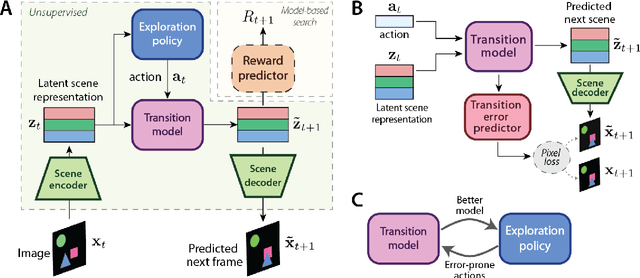
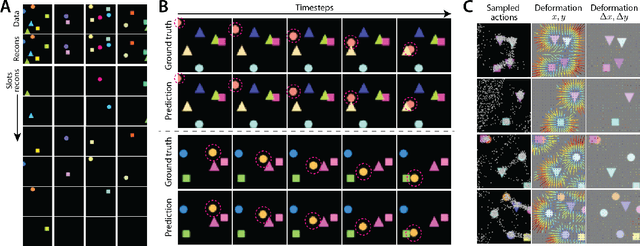
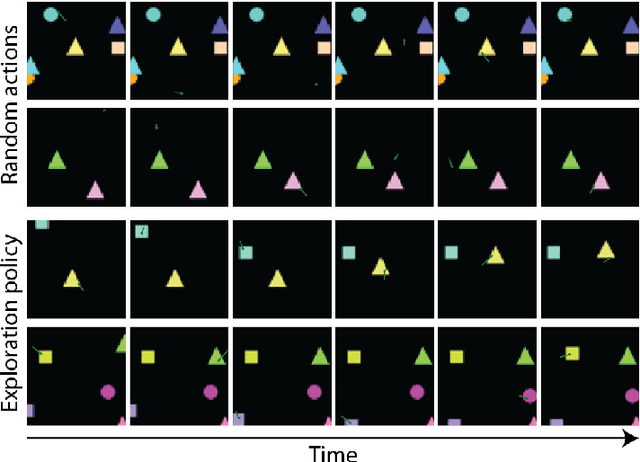
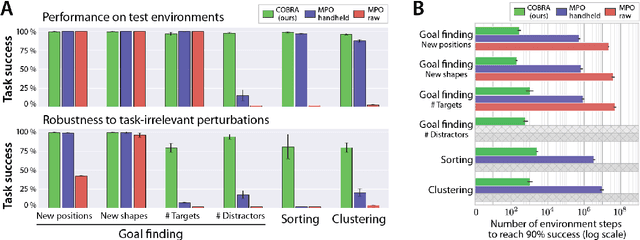
Abstract:Data efficiency and robustness to task-irrelevant perturbations are long-standing challenges for deep reinforcement learning algorithms. Here we introduce a modular approach to addressing these challenges in a continuous control environment, without using hand-crafted or supervised information. Our Curious Object-Based seaRch Agent (COBRA) uses task-free intrinsically motivated exploration and unsupervised learning to build object-based models of its environment and action space. Subsequently, it can learn a variety of tasks through model-based search in very few steps and excel on structured hold-out tests of policy robustness.
MONet: Unsupervised Scene Decomposition and Representation
Jan 22, 2019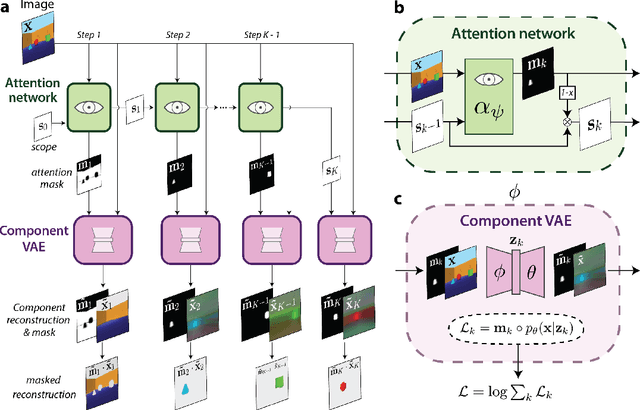
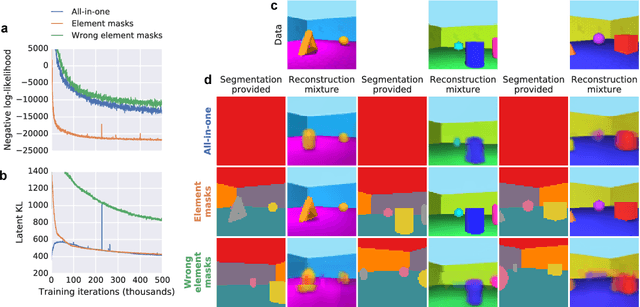
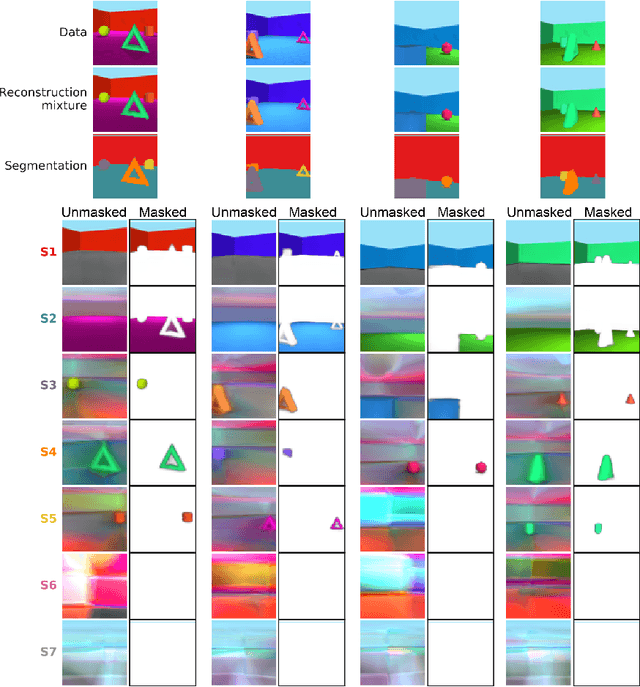
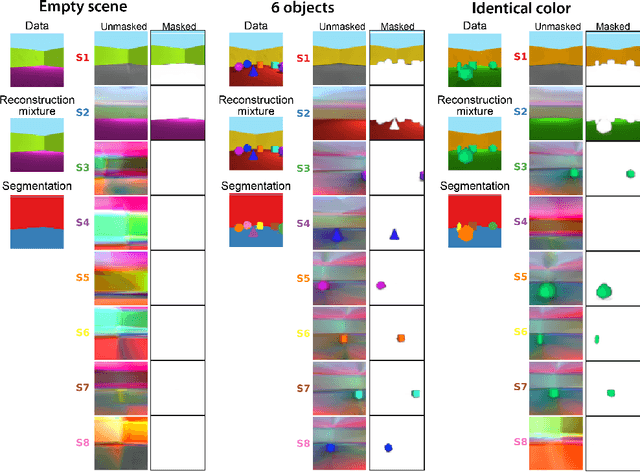
Abstract:The ability to decompose scenes in terms of abstract building blocks is crucial for general intelligence. Where those basic building blocks share meaningful properties, interactions and other regularities across scenes, such decompositions can simplify reasoning and facilitate imagination of novel scenarios. In particular, representing perceptual observations in terms of entities should improve data efficiency and transfer performance on a wide range of tasks. Thus we need models capable of discovering useful decompositions of scenes by identifying units with such regularities and representing them in a common format. To address this problem, we have developed the Multi-Object Network (MONet). In this model, a VAE is trained end-to-end together with a recurrent attention network -- in a purely unsupervised manner -- to provide attention masks around, and reconstructions of, regions of images. We show that this model is capable of learning to decompose and represent challenging 3D scenes into semantically meaningful components, such as objects and background elements.
Spatial Broadcast Decoder: A Simple Architecture for Learning Disentangled Representations in VAEs
Jan 21, 2019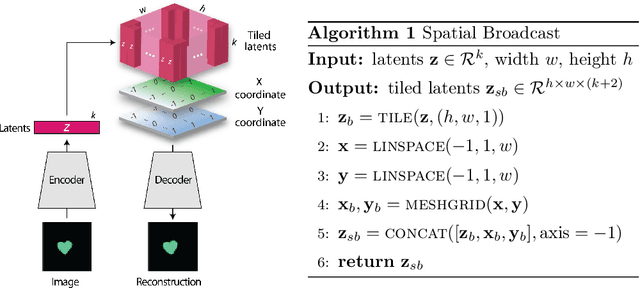
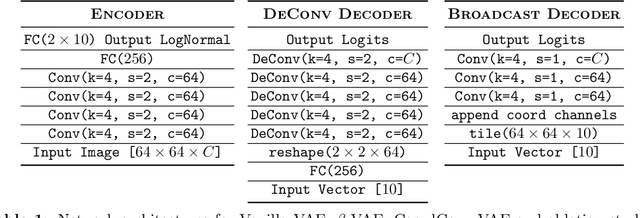
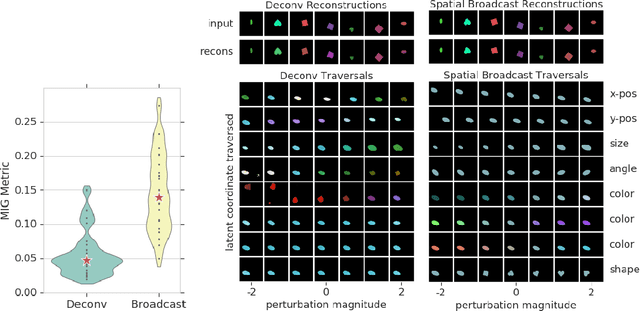

Abstract:We present a simple neural rendering architecture that helps variational autoencoders (VAEs) learn disentangled representations. Instead of the deconvolutional network typically used in the decoder of VAEs, we tile (broadcast) the latent vector across space, concatenate fixed X- and Y-"coordinate" channels, and apply a fully convolutional network with 1x1 stride. This provides an architectural prior for dissociating positional from non-positional features in the latent distribution of VAEs, yet without providing any explicit supervision to this effect. We show that this architecture, which we term the Spatial Broadcast decoder, improves disentangling, reconstruction accuracy, and generalization to held-out regions in data space. It provides a particularly dramatic benefit when applied to datasets with small objects. We also emphasize a method for visualizing learned latent spaces that helped us diagnose our models and may prove useful for others aiming to assess data representations. Finally, we show the Spatial Broadcast Decoder is complementary to state-of-the-art (SOTA) disentangling techniques and when incorporated improves their performance.
Life-Long Disentangled Representation Learning with Cross-Domain Latent Homologies
Aug 20, 2018

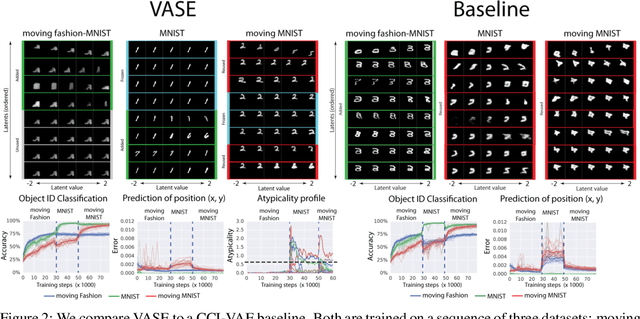

Abstract:Intelligent behaviour in the real-world requires the ability to acquire new knowledge from an ongoing sequence of experiences while preserving and reusing past knowledge. We propose a novel algorithm for unsupervised representation learning from piece-wise stationary visual data: Variational Autoencoder with Shared Embeddings (VASE). Based on the Minimum Description Length principle, VASE automatically detects shifts in the data distribution and allocates spare representational capacity to new knowledge, while simultaneously protecting previously learnt representations from catastrophic forgetting. Our approach encourages the learnt representations to be disentangled, which imparts a number of desirable properties: VASE can deal sensibly with ambiguous inputs, it can enhance its own representations through imagination-based exploration, and most importantly, it exhibits semantically meaningful sharing of latents between different datasets. Compared to baselines with entangled representations, our approach is able to reason beyond surface-level statistics and perform semantically meaningful cross-domain inference.
Understanding disentangling in $β$-VAE
Apr 10, 2018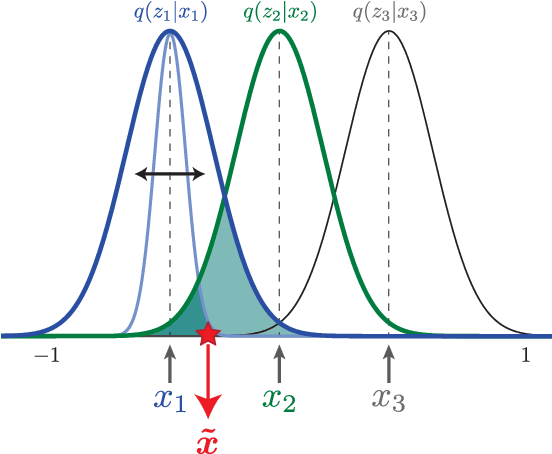
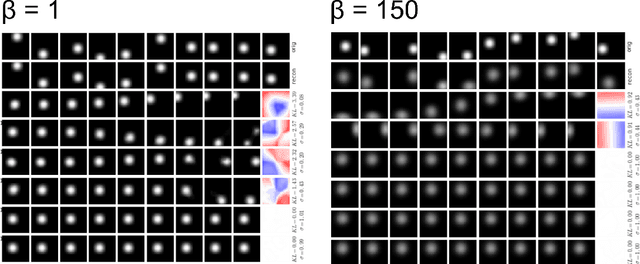
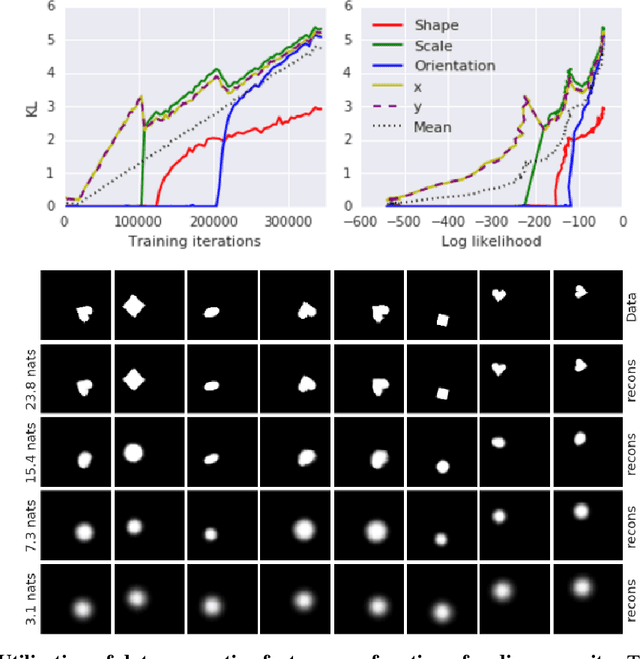

Abstract:We present new intuitions and theoretical assessments of the emergence of disentangled representation in variational autoencoders. Taking a rate-distortion theory perspective, we show the circumstances under which representations aligned with the underlying generative factors of variation of data emerge when optimising the modified ELBO bound in $\beta$-VAE, as training progresses. From these insights, we propose a modification to the training regime of $\beta$-VAE, that progressively increases the information capacity of the latent code during training. This modification facilitates the robust learning of disentangled representations in $\beta$-VAE, without the previous trade-off in reconstruction accuracy.
 Add to Chrome
Add to Chrome Add to Firefox
Add to Firefox Add to Edge
Add to Edge